2020 marks the 100th anniversary of the 19th Amendment, which recognized women’s right to vote. On paper, it seemed to expand voting rights to all women, but in practice, it would be decades before Black, Indigenous and People of Color (BIPOC) would be able to exercise that right. The centennial commemoration provides an opportunity to review the uneven expansion of voting rights in America. This timeline denotes milestones in that process, highlighting those who were enfranchised, and noting those who were not. It is a resource intended to support ongoing education about voting rights and what that means for equity and equality in this country.
Voting Rights Timeline
1787
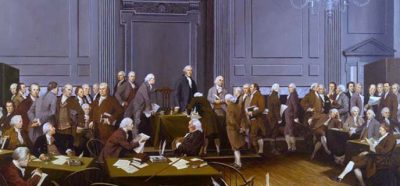
The signing of the United States Constitution by Louis S. Glanzman, 1987.
Three-Fifths Compromise
The United States Constitutional Convention decides to count three out of five slaves as people for tax purposes. The Compromise gives 1/3 more seats and 1/3 more electoral votes to the Southern States.
1807
No Votes for Women
Women are officially denied the right to vote in every state.
New Jersey was the first state to legally deny women the right to vote and started a chain reaction with every other state following its path.
Women would not have the right to vote for the next 113 years and women of color would face discrimination until 1964.
1848

General Scott’s entrance into Mexico in the Mexican-American War. Hand-colored lithograph; original size of painted area: 43.2×28.2 cm.
Source: University of Texas – Arlington
No Votes for Women
The Treaty of Guadalupe Hidalgo offers U.S. citizenship to the people living in the newly transferred Mexican Territory, extending the right to vote to property owners.
Even though they had the right, many Mexican Americans still faced threats when trying to cast their vote.
1848

Representative Women Source: https://www.loc.gov/resource/pga.07910/
Women’s Rights and Anti-slavery Activists Unite
The first women’s rights convention in the United States is held in New York.
This became known as the Seneca Falls Convention. It would ultimately begin the national women’s suffrage movement. The convention involved mostly white women.
1848

Frederick Douglass DOI: ppmsca 56175 Source: http://loc.gov/pictures/resource/ppmsca.56175/
Frederick Douglass Speaks at Womens’ Rights Convention
Former slave and newspaper editor Frederick Douglass attends the women’s rights convention in Seneca Falls, New York. He gives a speech in support of universal voting rights.
1863

Map of the Gadsden Purchase : Sonora and portions of New Mexico, Chihuaua & California Source: Library of Congress.
Arizona becomes a territory
Every white male citizen of the United States and/or white male citizen of Mexico who had become a citizen under the Gadsden Purchase was entitled to vote for any election.
• Voter turnout was scarce during the initial years
• 1864 – 885 people voted
• 1865 – 1,343 people voted
• 1866 – 1,695 people voted
1868
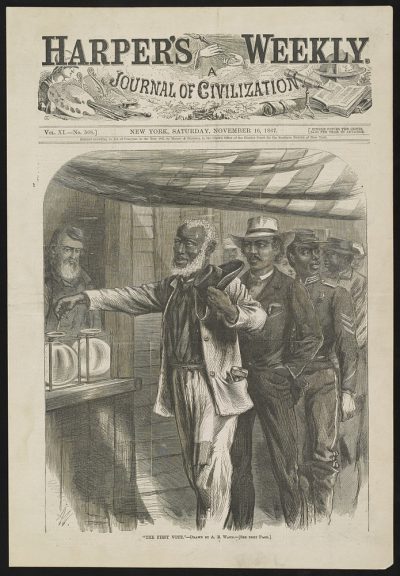
“The first vote” AW [monogram]; drawn by A. R. Waud Source: Library of Congress.
14th Amendment
The 14th Amendment grants “all persons born or naturalized in the United States” citizenship and the right to vote.
• This law is primarily created to ensure newly freed slaves have the right to vote.
• The amendment applied to African Americans and Mexican Americans, but not Native Americans or women.
1870

The Fifteenth Amendment and its results/drawn by G.F. Kahl Source: Library of Congress.
15th Amendment
The 15th Amendment builds on the 14th Amendment, clarifying that states cannot deny anyone the right to vote “on account of race, color, or previous condition of servitude.”
• The amendment is passed to counteract some state-led efforts to prevent people of color from voting.
1872

Anthony, Susan B. Source: Library of Congress.
United States v. Susan B. Anthony
Police in Rochester, New York arrest suffragist leader Susan B. Anthony for trying to vote in a presidential election.
• U.S. Supreme Court Justice Ward Hurd, tells the jury to find Anthony guilty without discussing the case.
• On the final day of her trial she is finally offered the chance to speak, giving what is regarded as one of the greatest speeches for women’s suffrage:
“It was we, the people; not we, the white male citizens; nor yet we, the male citizens; but we, the whole people, who formed the Union. And we formed it, not to give the blessings of liberty, but to secure them; not to the half of ourselves and the half of our posterity, but to the whole people – women as well as men.”
1882

The only one barred out Enlightened American statesman – “We must draw the line somewhere, you know.” Source: Library of Congress.
Chinese are not American
The Chinese Exclusion Act prevents anyone of Chinese descent from becoming a U.S. citizen.
• The act is a continuation of the Page Act, which banned Chinese women from immigrating to the United States.
• The Chinese Exclusion Act is the first law that targeted a specific national/ethnic group.
• Arizona legislation voted to restrict various Chinese businesses from operating such as, laundries and opium dens.
1887
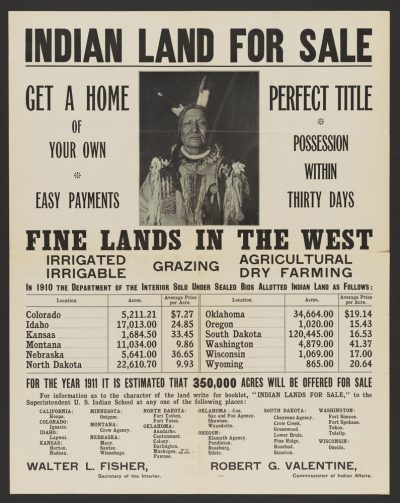
Indian land for sale Source: Library of Congress.
The Dawes Act
The Dawes Act grants Native Americans U.S. citizenship if they gave up their reservation land claim and native culture to adopt “the habits of civilized life.”
• The act was supposed to protect Native American land rights, but it resulted in indigenous people losing thousands of acres to outside settlers
1890

Move on! Has the Native American no rights that the naturalized American is bound to respect? Source: Library of Congress.
The Indian Naturalization Act
The Indian Naturalization Act allows Native Americans to apply for citizenship.
• This only applies to Native Americans living in the “Indian Territory,” or modern day Oklahoma.
1891

Conners, Jo. ed. (1913). Who’s who in Arizona. Vol I. Tucson: Arizona Daily Star. p 603. OCLC 8862523. Source: books.google.com.
The Mother of Arizona
Josephine Brawley Hughes created the first women’s suffrage organization in Arizona. Hughes pushed for women’s right to vote to be included in the new state constitution.
• President Benjamin Harrison rejected Arizona’s bid for statehood, thus legally derailing women’s suffrage in the state.
1900s

Photo of Pauline O’Neill. Original source: unknown Source: findagrave.com/memorial/….
First Arizona Suffrage Bill
Arizona suffragists came close to passing a bill in 1903. Unfortunately, Territorial Governor Alexander Brodie vetoed it. He believed allowing women to be eligible to vote would hurt Arizona’s chance for statehood.
• Pauline O’Neill had served as the President of the Arizona Territorial Women’s Suffrage Association for several years. O’Neill and her friend, Frances Munds, reached out to Mormon women about supporting the movement.
1912

Mrs. Frances W. Munds Source: Library of Congress.
Arizona adopts Women’s Suffrage
Arizona, Oregon, and Kansas each approve state constitutional amendments for women’s suffrage.
• Frances W. Munds leads Arizona’s suffrage movement. She became a state senator five years before the U.S. ratified the 19th Amendment.
1913

Suffrage Parade Source: Library of Congress.
Women March for their Voting Rights
Women’s suffrage marches take place in several prominent cities, including New York and Washington D.C.
• Their focus is getting a national constitutional amendment for women’s suffrage, so that women would be able to exercise the right to vote in every state.
• Mrs. Weller represents Arizona in a Washington D.C. march.

Mrs. Weller of Arizona. Source: Library of Congress.
1920

Headline of Washington Evening Star, August 26, 1920: “Suffrage proclaimed by [Bainbridge] Colby [Sec’y of State]…50-year struggle ends in victory for women” Source: Library of Congress.
White Women Gain the Right to Vote in the United States
Congress passes the 19th Amendment of the United States Constitution, granting women the right to vote on both state and federal levels.
• The National American Woman Suffrage Association supports the war effort during World War I, helping change the perception of women as passive and peaceful.
• Due to their patriotic wartime service, they made the case that denying women the right to vote contradicts the entire war they are fighting abroad.

Conferring over ratification [of the 19th Amendment to the U.S. Constitution] at [National Woman’s Party] headquarters, Jackson Pl[ace] [Washington, D.C.]. L-R Mrs. Lawrence Lewis, Mrs. Abby Scott Baker, Anita Pollitzer, Alice Paul, Florence Boeckel, Mabel Vernon (standing, right) Source: Library of Congress.
1924
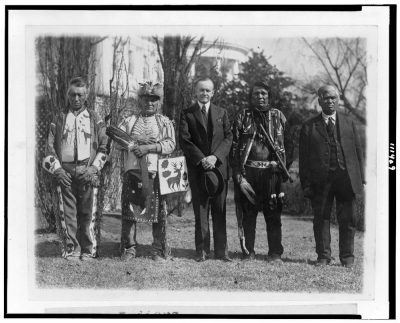
President Calvin Coolidge posed with Natives, possibly from the Plateau area in the Northwestern United States, near the south lawn of the White House Source: Library of Congress.
Indian Citizenship Act
The Indian Citizenship Act grants U.S. citizenship to all Native Americans, regardless of nation or tribe.
• The United States government had specifically omitted Native Americans from previous citizenship related legislation.
• Some states did not allow Native Americans to officially vote until the 1960s.
1930s

Original color transparency of FDR taken at 1944 Official Campaign Portrait session by Leon A. Perskie, Hyde Park, New York, August 21, 1944. Gift of Beatrice Perskie Foxman and Dr. Stanley B. Foxman. Source: https://www.flickr.com/people/54078784.
Increased Voter Turnout
By the 1930s, the amount of people voting in the presidential election increased nationally.
• 1928 – 56.9 million people voted • 1932 – 56.9 million people voted • 1936 – 61 million people voted
Arizona also saw a significant change in voter turnout as well.
• Arizona in 1928 – 91,254 people voted • Arizona in 1932 – 118,251 people voted • Arizona in 1936 – 124,163 people voted
1943

Repeal of Chinese, Hindu, Japanese Immigration Ban Source: Library of Congress.
Magnuson Act/Chinese Exclusion Repeal Act
The Magnuson Act repeals the 1882 Chinese Exclusion Act and extends the right to become a naturalized citizen to “Chinese persons or persons of Chinese descent.”
1965

O. J. Rapp. President Lyndon B. Johnson (1908–1973) speaks to the nation before signing the Civil Rights Act of 1964, July 2, 1964. Facsimile. Courtesy of the Lyndon Baines Johnson Presidential Library and Museum, Austin, Texas (267.01.00) Source: Library of Congress.
Voting Rights Act
The federal legislation legally prohibits any kind of racial discrimination in voting.
• President Lyndon B. Johnson signs the act during the civil rights movement.
• It officially recognizes that racial minorities have the right to vote and is considered the most important federal civil rights legislation of the 20th century.
1971
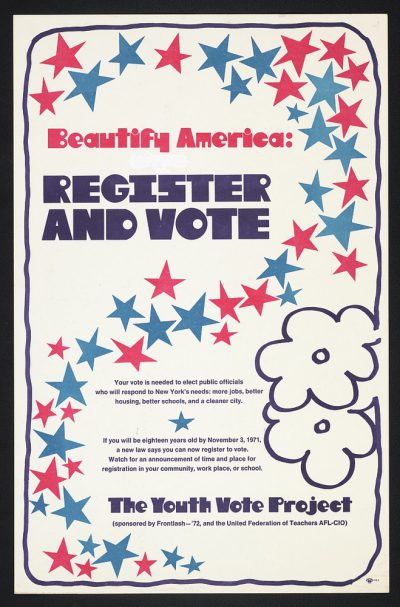
Beautify America – register and vote Source: Library of Congress.
26th Amendment
The 26th Amendment changes the voting age minimum from 21 years old to 18 years old.
• This amendment was a response to the Vietnam War, since 18 to 21-year-old men could be drafted to fight but could not vote.






